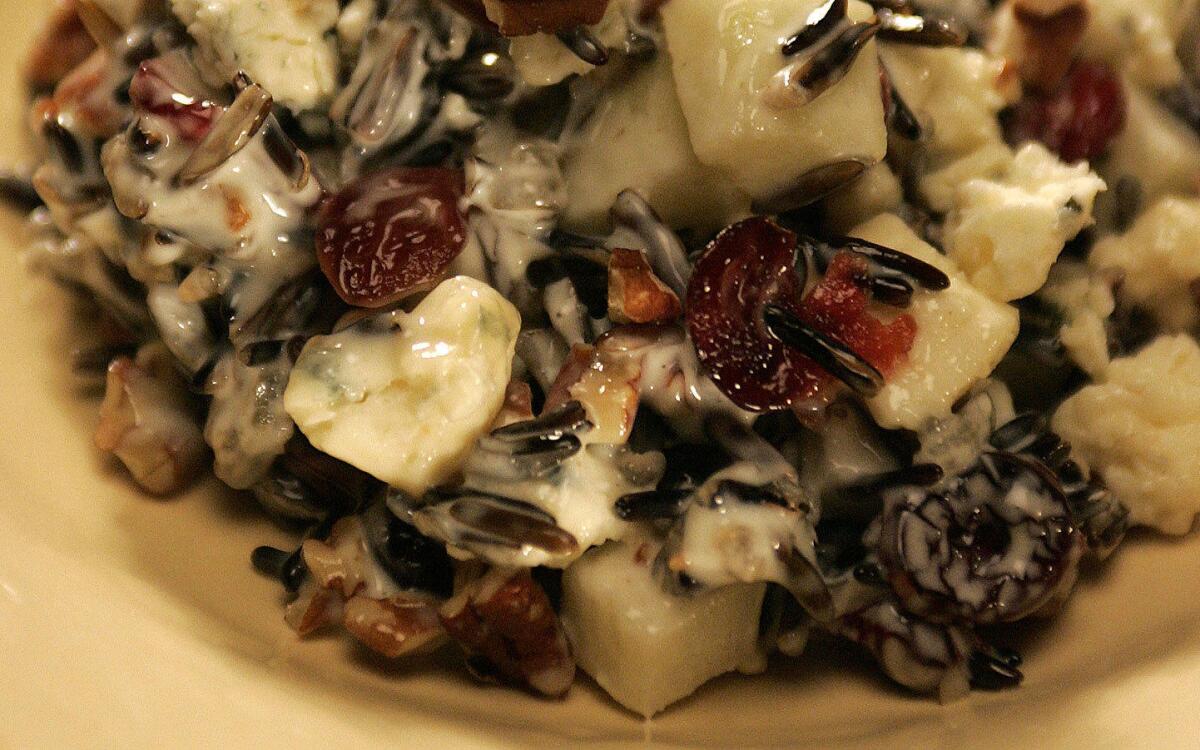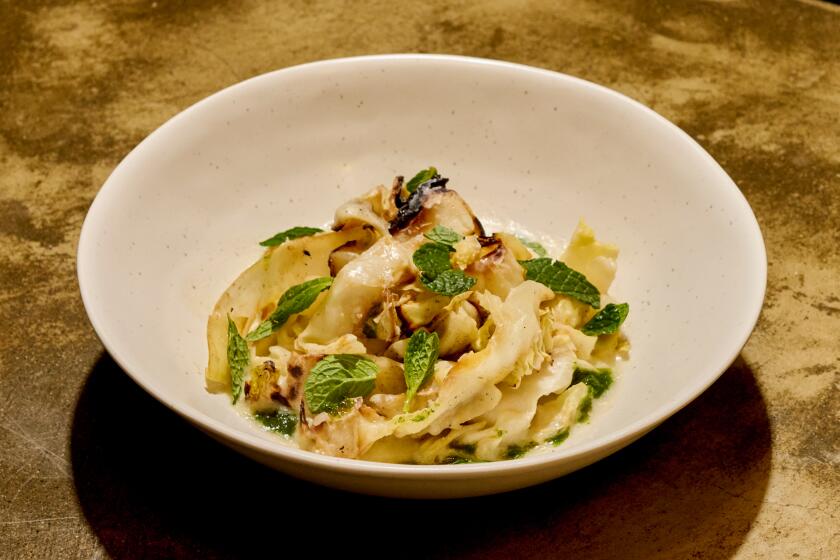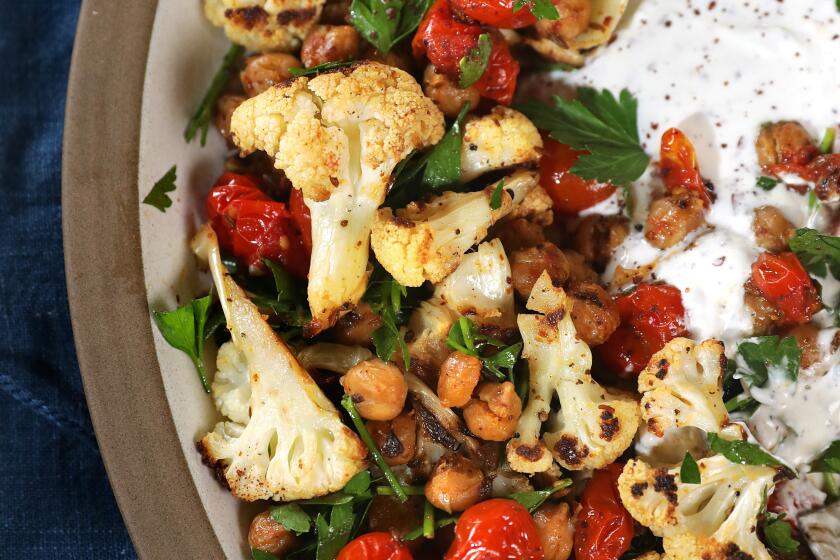Apple-wild rice salad with blue cheese and Calvados dressing

David Gremmels and Cary Bryant could be considered the accidental cheese makers.
Three years ago they were scouting for blue cheese to stock a wine bar they planned to open in Oregon when they happened on Rogue Creamery in Central Point, which had been making a Roquefort-style cheese since 1957. They tried it, they liked it and then the 75-year-old owner, Ignacio Vella, dropped a bombshell: âGentlemen, if you want my cheese, youâre going to have to make it yourself. Iâm going to close it down.â
They âbought on a handshake,â Gremmels said, and within two months were up to their elbows in curds and mold. Vella, whose family also owns the well-regarded Sonoma company that makes Dry Jack cheese, stayed on to teach them (heâs still officially master cheese maker). Soon Bryant was putting his microbiology degree to work tweaking Rogueâs recipes, one for Oregon Blue Vein that was brought by Vellaâs father from France and the other for Oregonzola, named by Vellaâs daughter for his variation on the Italian original. Every year since, Rogue has been steadily developing new varieties of blue with character all their own, cheeses that are American to the nubbly core but are racking up awards even in the land of Stilton.
And Rogue is just one of the many artisanal cheese makers now churning out blues that hold up against or even surpass the European classics.
Simultaneously creamy, crumbly, sweet and salty, these new blues are anything but an acquired taste. Theyâre sophisticated and nuanced but still accessible. You can eat them on a cracker or showcase them in recipes, and always you get unique flavor, mellow but sharp, with all the hallmarks of a superb Burgundy. They even seem to induce wine-speak, with aficionados finding hints of berries and caramel and hazelnuts in a single buttery bite.
Like all the great pungent, veiny cheeses, the new Americans go with everything you want to eat right now: pecans and pears, apples and walnuts, cranberries and bitter greens, grilled beef and roast pork, even pasta and polenta. The flavor, the texture and the creaminess harmonize with nearly every other brink-of-winter ingredient, and thatâs before you even get out the Port.
A category of cheese essentially dominated for 64 years by Maytag Blue out of Iowa now includes variations from coast to coast: from California to New York and Massachusetts, with stopovers in Colorado and Louisiana and Vermont. Terroir is a pretentious word, but tasting these cheeses can give you a hint of how connected the Oregon grass the cows eat is to the Crater Lake blue you spread on a sliced baguette.
As Gremmels notes, culinary artisans in all fields in this country âare very open to mixing and blending and looking at things creatively,â whether varietals for wine or hops for beer or molds -- and milks -- for cheese. (After experimenting, Rogue now produces Echo Mountain Harvest Blue in limited supply using part goatâs milk and part cowâs; one of its latest innovations comes wrapped in Merlot and Syrah grapevine leaves macerated in Oregonâs Clear Creek pear brandy.) No one today is trying just to emulate the European classics. They are making truly American cheeses for Americans who are better educated about food in general, well traveled and open to new tastes.
Naturally, these new blues do not vary as discernibly as French Roquefort and Spanish Cabrales (crumbly and made from sheepâs milk, or from a blend of sheepâs, cowâs and goatâs milk) do from Italian Gorgonzola (often almost Brie-like and made from cowâs milk). Most are fairly creamy, assertive but not overpowering, and nearly all can be used interchangeably in cooking. Lay them out side by side and the main difference will be in the tone of the veining -- some are more green, some more blue, some more mottled.
Like all blue cheeses, the domestic kind are produced by a time-honored method, with mold called penicillium roqueforti injected to create the distinctive flavor. Most of the American blues are made from raw cowâs milk and are aged four to six months.
*
Uniquely local
BOTH the Cheese Store of Silverlake and the Cheese Store of Beverly Hills report doing a good business in American blues, especially as the quality and variety have improved. Chris Pollan, the proprietor of Silverlake, says he carries around half a dozen kinds, as does Norbert Wabnig at the Beverly Hills shop, who even has one called Shaftâs that is aged in an old mining shaft. Online dealers such as www.igourmet.com also carry a good assortment. (Some cheese makers sell from their own websites, but usually only in hefty proportions.)
Of the nine American blues I tried, two were decidedly different. Bayley Hazen, from Jasper Hill Farm in Greensboro, Vt., is firm and crumbly, with a strong underpinning of blue mold and just enough salt. Itâs almost nutty-tasting and not at all creamy-rich. If you think blue cheese should be in-your-nose aggressive, more Stilton than Danish blue, this is the right choice.
Rogueâs Smokey Blue is also simply extraordinary. Cold-smoked over Oregon hazelnut shells, it starts out on your palate as a typical sublime blue but finishes just like smoke, in the best way. Eating it plain is addictive, but it also has a wondrous effect in cooking, particularly as a topping for char-roasted green beans and grilled meat. Gremmels says chefs particularly love it with salmon, stuffed into morels or crumbled onto salads.
At the other extreme is Point Reyes Original Blue, from a cheese maker on Tomales Bay in Northern California. More white than blue, it borders on bland, which is a cardinal sin in cheeseland. No wonder it is most often served at fancy food shows mixed into a dip with lots of sour cream. This is blue cheese for Colby Longhorn lovers, or for beginners willing to take baby steps.
Maytag Blue seems to be the baseline for most of the newer cheese makers. A dairy in Newton, Iowa, started by the grandson of the founder of the Maytag appliance company, now churns out more than 1 million pounds of this crumbly cheese every year. Itâs deeply mottled with green-blue mold and has a potent but not overpowering flavor, alone or especially in any salad.
Rogue River produces other cheeses that evoke Maytagâs, but with specific Northwest character -- particularly its Crater Lake blue and Oregon Blue Vein, both aged in caves just as Roquefort is in France. (Vellaâs father studied there and brought the original cultures to the United States along with plans for the caves.) Crater Lake is delicately but deeply veined and tastes of cream and salt first, bracing mold last. Itâs superb. Oregon Blue Vein is more in-your-mouth tangy/salty, but has a lovely creamy center.
From the other side of the country, Great Hill Blue, made in Buzzardâs Bay, on Massachusettsâ Cape Cod, is another lively standout -- almost the consistency of cream cheese but with very, very potent flavor. The veining is easily the most delicate of all these cheeses except Point Reyes, which has less immediate sharpness. By contrast, Bingham Hill Rustic Blue, from Fort Collins, Colo., has a texture more like a great cheddar: firm and dry, and a smooth and mellow, almost nutty taste.
All these blues also submit to cooking without losing their personality. Melt them with half-and-half to make a quick sauce for broccoli or cauliflower. Crumble them over hot polenta. Toss them with pasta, with or without pistachios or other nuts and sauteed leeks. Stuff them into mushrooms to be baked. Toss them into salads, especially with endives or frisee and other richness such as lardons and/or poached eggs, but also salads with fruit -- pears, apples or persimmons are naturals. Spread them on a grilled burger or tuck them into an omelet with spinach.
In a country where blue cheese so often is relegated to the dip for Buffalo chicken wings and dressings for iceberg salad, the variety and sophistication of the new blues should seem unlikely. But then who would have imagined 25 years ago that goat cheese would not only shed its French euphemism of chevre but become almost as ubiquitous as Kraft Singles?
Blue cheese in an American vein
BLUE cheese is generally aged, but once cut from the wheel it has a surprisingly short lifespan. If possible, buy from a store that slices to order and wraps in paper. Any blue cheese you find already cut and wrapped is on its way to funky. Even sealing blue cheese in plastic wrap at home is a bad idea. A high water content combined with the mold puts a sublimely pungent cheese at higher risk of decaying into bitterness. Better to use wax paper or foil.
Most of the best American blue cheeses run around $18 to $20 a pound, but prices vary widely from source to source. When serving any blue cheese, use a knife warmed in hot water and slice all the way through -- the center is creamier and often milder than the hard, pungent outer area, and you want both distinctive taste sensations. In fact, this is one cheese to eat rind and all.
Bayley Hazen. A hard, sharp, wonderfully pungent blue from Vermont. Available at the Cheese Store of Silverlake, (323) 644-7511, $18 per pound.
Bingham Hill Rustic Blue. Another hard cheese, from Colorado, that is almost cheddary in texture, with a seriously mellow flavor. Available at the Cheese Store of Silverlake, $18 per pound; and at the Cheese Store of Beverly Hills, (310) 278-2855, $20 per pound.
Echo Mountain Harvest Blue. This fabulous limited-edition blue made with a blend of cowâs and goatâs milk is creamy, rich and well-balanced, with a lovely salt tang. Available at the Cheese Store of Beverly Hills, $30 per pound.
Great Hill Blue. A balanced blend of pungent and buttery smoothness from Cape Cod. Available at the Cheese Store of Silverlake and the Cheese Store of Beverly Hills, about $18 per pound.
Maytag Blue. The standard- setter from Iowa is always reliable; the taste and texture evoke a good Danish blue. Widely available, about $18 per pound.
Rogue Creamery Smokey Blue. Extraordinarily creamy and pungent and also seductively smoky. Available at the Cheese Store of Silverlake and the Cheese Store of Beverly Hills, about $18 per pound.
Rogue Creamery Oregon Blue Vein. A close American cousin of Roquefort, with a sharp but smooth flavor. Available at the Cheese Store of Beverly Hills, about $18 per pound.
Rogue Creamery Crater Lake. Creamier, nuanced but still sharply flavored in the best way. Available at the Cheese Store of Beverly Hills, about $18 per pound.
Point Reyes Blue. The mildest of the American blues. Available at Whole Foods, Bristol Farms and Gelsonâs. Prices vary from about $15 to $19 per pound.
-- Regina Schrambling
Simmer the cranberries in one-half cup Calvados in a small saucepan over low heat until all the liquid is absorbed, about 10 to 12 minutes. Set aside.
Place the egg yolk in a blender and add the salt, lemon juice, vinegar and mustard. Process until smooth. Add 2 tablespoons Calvados and process briefly. With the motor running on low speed, slowly drizzle in the walnut and peanut oils. Add the remaining Calvados to taste. Chill at least 30 minutes.
Peel and core the apple. Cut into half-inch dice. As you chop them, toss them in a bowl with about one-half cup of the dressing to keep them from discoloring.
Add the wild rice, pecans and cranberries and toss to combine, adding more dressing as needed. Stir in the blue cheese and serve.
Get our Cooking newsletter.
Your roundup of inspiring recipes and kitchen tricks.
You may occasionally receive promotional content from the Los Angeles Times.













